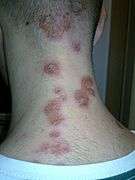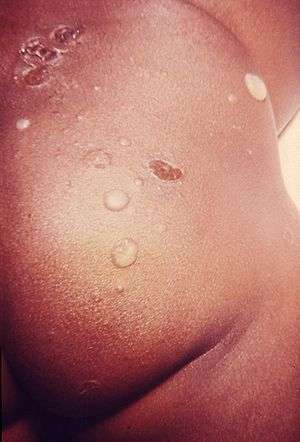Impetigo
| Impetigo | |
|---|---|
 | |
| A severe case of facial impetigo | |
| Pronunciation | /ɪmpᵻˈtaɪɡoʊ/ |
| Classification and external resources | |
| Specialty | Dermatology, infectious disease |
| ICD-10 | L01 |
| ICD-9-CM | 684 |
| DiseasesDB | 6753 |
| MedlinePlus | 000860 |
| eMedicine | derm/195 emerg/283 med/1163 ped/1172 |
| Patient UK | Impetigo |
| MeSH | D007169 |
Impetigo is a bacterial infection that involves the superficial skin. The most common presentation is yellowish crust on the face, arms, or legs. Less commonly there may be large blisters which affect the groin or armpits.[1] The lesions may be painful or itchy. Fever is uncommon.[2]
It is typically due to either Staphylococcus aureus or Streptococcus pyogenes.[2] Risk factors include attending daycare, crowding, poor nutrition, diabetes, contact sports, and breaks in the skin such as from mosquito bites, eczema, or scabies.[2][3] With contact it can spread around or between people. Diagnosis is typically based on the symptoms.[2]
Prevention is by handwashing, avoiding people who are infected, and cleaning injuries. Treatment is typically with antibiotic creams such as mupirocin or fusidic acid.[2][4] Antibiotics by mouth, such as cephalexin, may be used if large areas are affected.[2] Antibiotic resistant forms have been found.[2]
Impetigo affected about 140 million people (2% of the population) in 2010.[5] It is most common in young children but can occur at any age. Without treatment people typically get better within three weeks. Complications may include cellulitis or poststreptococcal glomerulonephritis.[2] The name is from the Latin impetere meaning "attack".[6]
Signs and symptoms
Contagious impetigo
This most common form of impetigo, also called nonbullous impetigo, most often begins as a red sore near the nose or mouth which soon breaks, leaking pus or fluid, and forms a honey-colored scab,[7] followed by a red mark which heals without leaving a scar. Sores are not painful, but they may be itchy. Lymph nodes in the affected area may be swollen, but fever is rare. Touching or scratching the sores may easily spread the infection to other parts of the body.[8] Ulcerations with redness and scarring also may result from scratching or abrading of the skin.
|
Bullous impetigo
Bullous impetigo, mainly seen in children younger than 2 years, involves painless, fluid-filled blisters, mostly on the arms, legs, and trunk, surrounded by red and itchy (but not sore) skin. The blisters may be large or small. After they break, they form yellow scabs.[8]
Ecthyma
In this form of impetigo, painful fluid- or pus-filled sores with redness of skin, usually on the arms and legs, become ulcers that penetrate deeper into the dermis. After they break open, they form hard, thick, gray-yellow scabs, which sometimes leave scars. Ecthyma may be accompanied by swollen lymph nodes in the affected area.[8]
Causes
It is primarily caused by Staphylococcus aureus, and sometimes by Streptococcus pyogenes.[9] Both bullous and nonbullous are primarily caused by S. aureus, with Streptococcus also commonly being involved in the nonbullous form.[10]
Predisposing factors
Impetigo is more likely to infect children ages 2-6, especially those that attend school or daycare. Other factors can increase the risk of contracting impetigo such as diabetes, dermatitis, immunodeficiency disorders, and other irritable skin disorders. [11] Impetigo occurs more frequently among people who live in warm climates.[12]
Transmission
The infection is spread by direct contact with lesions or with nasal carriers. The incubation period is 1–3 days after exposure to Streptococcus and 4–10 days for Staphylococcus.[13] Dried streptococci in the air are not infectious to intact skin. Scratching may spread the lesions.
Diagnosis
Impetigo is usually diagnosed based on its appearance. It generally appears as honey-colored scabs formed from dried serum, and is often found on the arms, legs, or face.[9] If a visual diagnosis is unclear a culture may be done to testing for resistant bacteria.[14]
Differential diagnosis
Other conditions that can result in symptoms similar to the common form include contact dermatitis, herpes simplex virus, discoid lupus, and scabies.[2]
Other conditions that can result in symptoms similar to the blistering form include other bullous skin diseases, burns, and necrotizing fasciitis.[2]
Prevention
To prevent spread of impetigo to other people the skin and any open wounds clean should be kept clean. Care should be taken to keep fluids from an infected person away from the skin of a non-infected person. Washing hands, linens, and affected areas will lower the likelihood of contact with infected fluids. Sores should be covered with a bandage. Scratching can spread the sores; keeping nails short will reduce the chances of spreading. Infected people should avoid contact with others and eliminate sharing of clothing or linens.[15]
Treatment
For generations, the disease was treated with an application of the antiseptic gentian violet.[16] Today, topical or oral antibiotics are usually prescribed. Mild cases may be treated with bactericidal ointment, such as mupirocin.
More severe cases require oral antibiotics, such as dicloxacillin, flucloxacillin, or erythromycin. Alternatively, amoxicillin combined with clavulanate potassium, cephalosporins (first-generation) and many others may also be used as an antibiotic treatment. Alternatives for people who are seriously allergic to penicillin or infections with MRSA include doxycycline, clindamycin, and SMX-TMP. When streptococci alone are the cause, penicillin is the drug of choice.
Alternative medicine
There is not enough evidence to recommend alternative medicine such as tea tree oil or honey.[2]
Prognosis
Without treatment people typically get better within three weeks. Complications may include cellulitis or poststreptococcal glomerulonephritis. Rheumatic fever does not appear to be related.[2]
Epidemiology
Globally, impetigo affected about 140 million people (2% of the population) in 2010.[5]
Society and culture
It is also known as school sores.[17]
References
- ↑ Ibrahim, F; Khan, T; Pujalte, GG (December 2015). "Bacterial Skin Infections.". Primary care. 42 (4): 485–99. PMID 26612370.
- 1 2 3 4 5 6 7 8 9 10 11 12 Hartman-Adams, H; Banvard, C; Juckett, G (15 August 2014). "Impetigo: diagnosis and treatment.". American family physician. 90 (4): 229–35. PMID 25250996.
- ↑ Adams, BB (2002). "Dermatologic disorders of the athlete.". Sports medicine (Auckland, N.Z.). 32 (5): 309–21. PMID 11929358.
- ↑ Koning, S; van der Sande, R; Verhagen, AP; van Suijlekom-Smit, LW; Morris, AD; Butler, CC; Berger, M; van der Wouden, JC (18 January 2012). "Interventions for impetigo.". The Cochrane database of systematic reviews. 1: CD003261. PMID 22258953.
- 1 2 Vos, T (Dec 15, 2012). "Years lived with disability (YLDs) for 1160 sequelae of 289 diseases and injuries 1990-2010: a systematic analysis for the Global Burden of Disease Study 2010.". Lancet. 380 (9859): 2163–96. doi:10.1016/S0140-6736(12)61729-2. PMID 23245607.
- ↑ Limited, Wordsworth Editions (1993). Concise English Dictionary. Wordsworth Editions. p. 452. ISBN 9781840224979.
- ↑ Cole C, Gazewood J (2007). "Diagnosis and treatment of impetigo". Am Fam Physician. 75 (6): 859–64. ISSN 0002-838X. PMID 17390597.
- 1 2 3 Mayo Clinic staff (5 October 2010). "Impetigo". Mayo Clinic Health Information. Mayo Clinic. Retrieved 25 August 2012.
- 1 2 Kumar, Vinay; Abbas, Abul K.; Fausto, Nelson; & Mitchell, Richard N. (2007). Robbins Basic Pathology (8th ed.). Saunders Elsevier. pp. 843 ISBN 978-1-4160-2973-1
- ↑ Stulberg DL, Penrod MA, Blatny RA (2002). "Common bacterial skin infections.". American Family Physician. 66 (1): 119–24. PMID 12126026.
- ↑ "Impetigo". Healthline. Retrieved 7 October 2016.
- ↑ Tamparo, Carol; Lewis, Marcia (2011). Diseases of the Human Body. Philadelphia, PA: F.A. Davis Company. p. 194. ISBN 9780803625051.
- ↑ "ISDH: Impetigo". state.in.us. Retrieved 11 December 2014.
- ↑ "Impetigo: MedlinePlus Medical Encyclopedia". medlineplus.gov.
- ↑ "Self-management - Impetigo - Mayo Clinic". www.mayoclinic.org. Retrieved 7 October 2016.
- ↑ MacDonald RS (October 2004). "Treatment of impetigo: Paint it blue". BMJ. 329 (7472): 979. doi:10.1136/bmj.329.7472.979. PMC 524121
 . PMID 15499130.
. PMID 15499130. - ↑ Impetigo — school sores — Better Health Channel
External links
- Impetigo at DMOZ
- Impetigo and Ecthyma at Merck Manual of Diagnosis and Therapy Professional Edition
.jpg)

